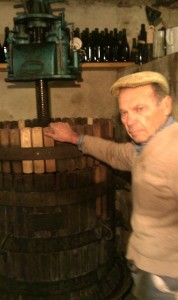Nov 23, 2009
Natural Wine Making in Piemonte Part IX – "Time to Press!"
Here you will find a transcript from my phone call to Jørgen in Italy (the leader of this project). I apologize in advance for this really looking like an exact transcript of our conversation (warning, this post gets a bit technical):
Friday & Saturday, November 13th & 14th 2009
“Analysis was done to check if fermentation was complete. Checked the skins. Not much flavor left nor color, so we decided to press and remove the good wine and free run juice. Only the free run juice will become the wine in our bottle. The last 150 liters from each tank will not be used nor will the wine from the press be used, approx 500 liters. The skin was quite dry after the free run juice was removed. The free run juice was placed in one cement tank of 4000 liters (this decision was made after speaking with natural and non natural wine producers). No pump-overs nor “racking” since the very beginning (except removing the free run juice). No “botti grandi” will be used because the tannins are very mature, not aggressive AND THEREFORE WE DON’T WANT TO EXPOSE THE WINE TO ANY UN-NECESSARY AIR. Because of good grape maturation, the tannins are sweet and good.”
“The alcoholic fermentation is not totally complete yet, about 4 grams of sugar left and the wine is still fermenting . The lactic acid is at zero (the Malo is at 1.46, THIS IS QUITE LOW), so the malolactic conversion has not yet begun. The VA (Volatile Acidity) is at 0.26 which is very low and good.”
“The natural sulfur from the fermentation was analyzed (the analysis was done by hand in the lab to be totally accurate). If sulfur had been added during the wine-making process, you would be able to check this by machine, but since we didn’t add any, it must be analyzed by hand. The result was 26mg per liter where 12mg is free SO2”
“The wine has a very high extraction equal to 30.97 grams per liter. A good Barolo, for example, would be between 29-33 grams per liter. Remember that this wine will be bottled as a Vino da Tavola, not a Barolo! Jørgen also visited Mr. Aldo Vajra (of Azienda Agricola G.D Vajra). Aldo Vajra used to be a teacher at La Scuola di Enologia in Alba (The School of Enology in Alba, Italy). The analysis was brought to him because the PH and the total acidity levels were a bit low (PH 337 and total acidity is 6.3). Aldo explained that these readings were because of the very high measures of potassium (a salt, which lowers the total acidity level). When the cellar gets cold, the potassium with the tartaric acid form crystals which will fall to the bottom of the tank. When this happens, the acidity level will rise again as the level of potassium decreases. Since this is our first wine, we are analyzing more often then we will when we make wine next year. We are nervous about our first baby! Aldo also said “Sei appostissimo! Non ti preoccupare!” – translated means “Things are perfect! Don’t worry!”
Tasting (drinking) of the wine: “it’s balanced and leaves the mouth very clean and fresh. High and mature tannins. A liter of wine was consumed this evening by Jørgen and the “Carussin” family and the wine was fantastic!! The “Carussin” family were surprised that the wine was so clean. Even the color was deeper than expected.”
“The plan now is to (the tank is closed and still fermenting) leave the wine alone until the malo acid converts over to lactic acid which could happen this week or in early spring as the air warms a bit.”
We have decided to bottle the wine (hopefully next year) using the same system as used for Moscato d’asti so as not to expose the wine to any air when bottling.”






